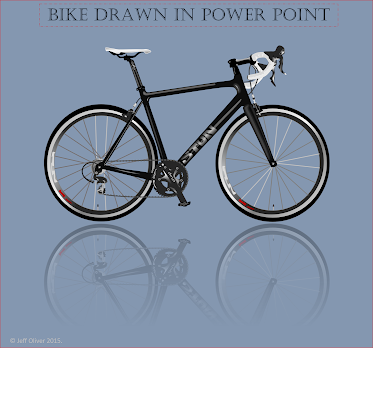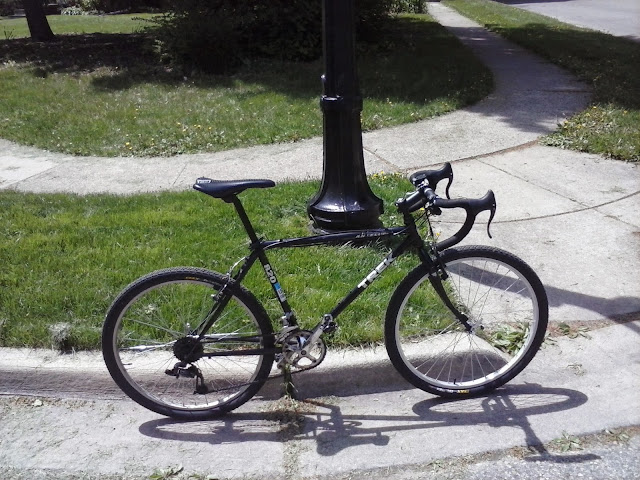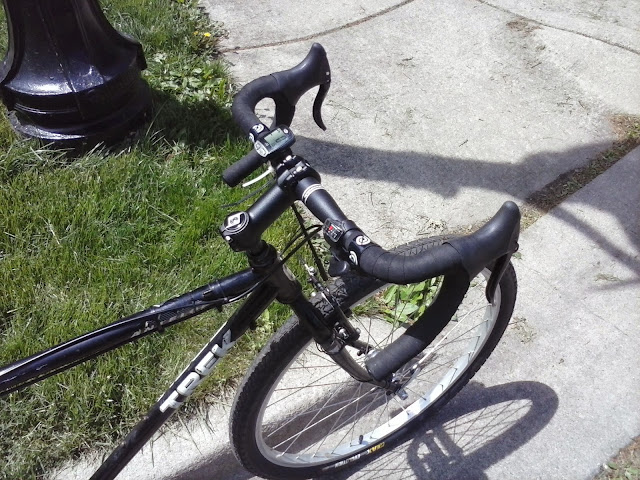No problem.
Except that a lot of runners don't do it! Why don't they? It's a mystery of the universe, like why the Chia Pet came into existence or why people have Magic 8 balls.
Putting together a good running schedule can be very complex: Long run should be no more than 1/3 total weekly mileage, only increase weekly mileage or any single run by 10% a week, keep turnover at 180 and alter stride rate to change speed, threshold runs should account for 10% of mileage...etc...etc...etc..
But really, it doesn't have to be. I once heard a theory from a pretty seasoned runner giving advice to new runners: Just go run every day (AH! That is not C25K approved!!) but pay attention to how you feel.
IS IT REALLY THAT SIMPLE?
Maybe. Think about it. Your body knows what it can handle if you learn how to listen to it! And I think a lot more of us know how to listen to it than we know. I bet most of us would be GREAT listeners IF WE TURNED THE GPS OFF!
Ok. You don't have to turn it OFF...it's a great, easy way to keep your fitness journal with just two clicks of a button. But don't listen to it or look at it while you run.
THE PROBLEM IS THAT TOO MANY OF US ARE TRYING TO PROVE SOMETHING.
To ourselves, our Runkeeper friends, the people watching you from their car...whoever...STOP IT! IT REALLY DOESN'T MATTER!
Most of us aren't worried about going too fast either. It's the slow run that kills us. Remember in the movie "Remember the Titans" when the quarterback is struggling with the pitch-out, and Denzel Washington's character says something like, "You can throw the ball a mile, but you can't pitch it three feet." That's what running is like. READ MY LIPS:
YOU WILL NEVER (NEVER) KNOW HOW FAST YOU CAN RUN UNTIL YOU LEARN TO RUN SLOW!
Why? It's just like learning a musical instrument. If you can't play a song at a PAINFULLY slow beat, you are probably not playing the right way when you play it fast. You really may just be covering your mistakes by rushing over things.
YOU HAVE RUNNING WEAKNESSES AND A LOT OF THEM CAN HIDE AT FASTER PACES.
I'll prove it to you: Go stand in the middle of the floor, stick one leg out and (with one leg extended) do a squat--just one--but there is only one rule--you have to take at least 60 seconds going down and coming back up.
How about this: Stand on one leg about a foot from a wall. Slowly tap the wall with your other knee in three places--to the left, center and right. Then go back to center and left. Repeat 10 times. Go as slow as you can.
What do these crazy routines have to do with anything? They both use muscles that are critical to good running form. I will bet my new running shoes that every 2:30 marathon runner could do either of these with no problems.
IF YOU CAN'T DO THEM, YOU PROBABLY HAVE NO BUSINESS RUNNING LIKE RUNNERS THAT CAN!
This is better illustrated through an example using a fictitious runner in two scenarios. It is the same runner in each, but with three different outcomes.
The running schedule is as follows:
Day 1: 5 miles easy plus strides
Day 2: 7 miles steady pace
Day 3: 4 x 1 mile @ 10K pace with 2:00 recovery between
Day 4: OFF
Day 5: 7 miles easy
Day 6: 10 miles with 3 at HM pace
THE RUNNER IS A 19:00 5K RUNNER
SCENARIO 1
Day 1: 5 miles easy plus strides
(The runner starts the run at 10mm pace. After a mile the GPS announces the pace. The runner thinks, "Oh no! I am getting slow! My slow pace should be at least 8:30 or so if I am really fit. Am I losing fitness?!" Subconsciously or consciously, the runner speeds up and really nails the strides. OVERALL PACE 7:15)
Day 2: 7 miles steady pace
(Impressed with their day yesterday, the runner is convinced they are pretty fit. They average 6:50 for the 7 miles and are SUPER impressed with their skills and happy to post the results on facebook. Their casual runner friends are super impressed.)
Day 3: 4 x 1 mile @ 10K pace with 2:00 recovery between
(Interval day! The perfect time to REALLY impress your casual runner friends! The 1 mile fast sections are going to be at 10K pace (around 6:18) so the runner imagines, "What if I push a little on the 2:00 recovery? I could maybe come in around 6:30 for the whole run." The runner does just that and is feeling pretty good. Plus they get to post a 6:30 pace run on facebook!)
Day 4: OFF
("OFF?! No way! I'm a champion! Look at my past week!" The runner thinks. So they do a 4 mile easy run instead, and it ends up being EASY because the runner is starting to feel some twinges in the joints and tendons...8:30 pace)
Day 5: 7 miles easy
(The runner wakes up unable to walk. DAY OFF--BY FORCE)
Day 6: 10 miles with 3 at HM pace
(10 miles?! The runner can't even think about 10 miles without the joints hurting. Plus the pulse is elevated, the runner feels a little achy and sick all over. "I better rest up so I can even run next week," the runner thinks. So...ANOTHER DAY OFF BY FORCE)
Day 7: OFF
RESULT 1:
Overtraining, sore joints and muscles that are too tight. Injury is likely!
Lack of aerobic fitness (too many runs too close to threshold)
Reduced mileage=less muscular, biomechanical and neurological development
22 mile week
7:40 pace average
SCENARIO 2
Day 1: 5 miles easy plus strides
(Easy means EASY. Fast means FAST. The runner takes the 5 miles at 9mm pace, and really hits the strides hard but controlled. Overall 8:30 pace.)
Day 2: 7 miles steady pace
("7:00mm pace should be "steady" enough to get the job done," The runner thinks. The runner makes sure not to look at the GPS and just runs a pace that is brisk, but the runner can still converse (no aerobic debt). The run ends up being right around 7:00. The runner felt like they could have easily hit 6:40 pace, but knows that intervals are coming up tomorrow and wants to hit that key workout feeling strong).
Day 3: 4 x 1 mile @ 10K pace with 2:00 recovery between
(The runner wants to really hit the fast sections hard so the warm-up, cool down and recovery are 10:30mm pace--just enough to keep the legs alive. The strides are around 6:18, but the slow sections bring the average pace to around 8:30. The runners friend posts their first run of the week: 7:10 pace for 4.5 miles. The runner thinks "Man, I'm faster than that friend by a lot! They're not going to know how fast I am if I keep posting these 8:30 workouts!" Then the runner tells himself to shut up. There is a rest day tomorrow, but a 7 to tire the legs out on day 6 followed by a key workout of 10 the next day. The runner knows he needs to stay fresh, and that the aerobic "miles in the bank" at 8:30 will pay big dividends without taking a big toll on the body.)
Day 4: OFF
(The runner feels under-worked at this point and wonders how they could be improving with so little effort. The 6:18 pace intervals remind him that he is keeping his fast-twitch muscle active and he decides to trust the day off as a time to rebuild muscle. He does 20 min cross train at an EASY pace (like 2/10 effort) just to keep blood flowing but does not tax the cardiovascular system, muscles or joints)
Day 5: 7 miles easy
(Easy means easy! This workout is not about proving anything to anybody. It is just to put aerobic miles in the bank for tomorrow. 8:45 pace.)
Day 6: 10 miles with 3 at HM pace
(The run goes great. 3 miles at 6:50 pace, the rest at 7:15. Average pace: 7:08.)
Day 7: OFF
(Knowing its good to have 1 day TOTALLY off. The runner sleeps in an hour and even walks slowly all day and does a lot of sitting)
RESULTS 2:
35 miles. Good balance of aerobic/anaerobic/speed workouts. Legs feel tired, but strong. The body feels good and is a little twingy at times but with fast recovery (only twingy for a day or so). Average pace: maybe 8:30 or so.
WHAT WILL PRODUCE A BETTER RACE A THE NEXT 5K? SCENARIO 2.
If you think otherwise, you probably have never tried option 2, which focuses on building leg strength over working the body's systems at their max. There is just enough aerobic, anaerobic and speed work to optimize the runner's performance. Plus, it's like they say, the best running miles are the ones that actually happen. In scenario 1, 13 miles never happened compared to scenario 2! (That's 38% fewer miles!!) Miles in the bank improve oxygen delivery, form, strength and neuro-muscular response--even the ones that don't tax the anaerobic system or bones and joints! If you short yourself in developing those processes--you will not improve as much.
Simple.
How do I know all this? Because the runner in both scenarios is me! Running slowly has revolutionized the way I train. I used to favor a three-a-week type schedule because I couldn't handle any more, but running slowly has let me build up the weekly mileage to see what kind of results I might get. Updates will follow!
However, I can already say that I think I have finally learned to run slowly and it's beautiful. Basically, you keep your feet light and almost "choppy" with the same high turnover rate. Slow running is low impact running that doesn't strain your joints or your anaerobic system nearly at all, but it is still a good workout. It requires more balance and core strength in my opinion and takes some real skill. As a 19 minute 5Ker I have become quite proud of my 10, 11 and 12 minute mile pace runs. It may sound strange but I feel a real sense of accomplishment in having learned to run at slow speeds because it takes a different kind of effort.
So the next time you see someone post a run with a pace that is 3 or 4 minutes per mile slower than marathon pace, give them your respect!





















